Home Bathroom Remodel: A Guide to Creating Your Dream Space
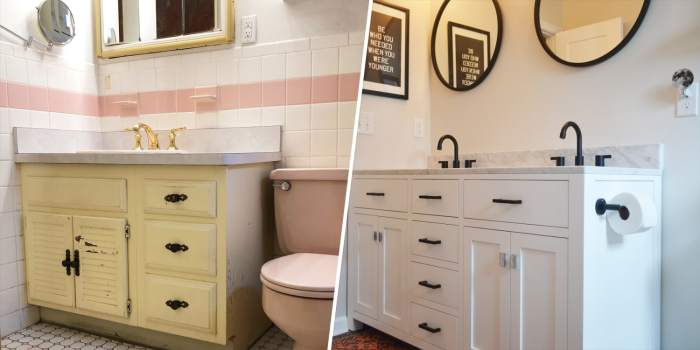
Home bathroom remodeling is an exciting project that can transform a mundane space into a luxurious oasis. Whether you’re looking to refresh your existing bathroom or embark on a complete overhaul, careful planning, and execution are key to achieving your desired results.
This guide provides a comprehensive overview of the bathroom remodel process, from initial planning to final touches, helping you navigate every step with confidence.
From choosing the right materials and fixtures to creating a functional and aesthetically pleasing layout, this guide will empower you to make informed decisions and bring your dream bathroom to life. We’ll delve into the intricacies of bathroom design, exploring various styles, trends, and essential features that will elevate your space.
Additionally, we’ll address practical considerations such as budgeting, safety, and accessibility, ensuring your remodel meets both your needs and your budget.
Planning Your Bathroom Remodel
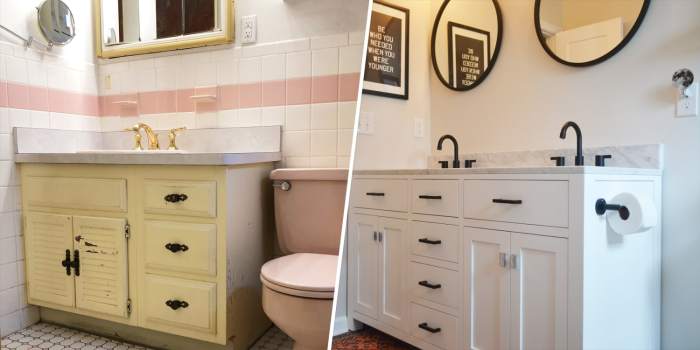
A bathroom remodel can significantly enhance your home’s value and your daily life. However, it’s essential to approach this project with a well-defined plan to ensure a successful outcome.
Setting a Realistic Budget
A clear budget is crucial for staying on track during your bathroom remodel. Failing to account for all potential costs can lead to project delays, stress, and even exceeding your financial limits. Here’s a breakdown of key factors to consider:
- Labor Costs: Contractors’ fees vary based on experience, location, and project complexity. Obtaining multiple quotes from reputable professionals is highly recommended.
- Materials: The cost of materials, including tiles, fixtures, and cabinetry, can fluctuate greatly. Research different options and consider the long-term durability and aesthetics of each material.
- Permits and Inspections: Depending on your location, you may need to obtain permits and undergo inspections. Incorporate these costs into your budget.
- Unexpected Expenses: It’s always wise to allocate a contingency fund for unforeseen issues, such as hidden plumbing problems or structural repairs.
Creating a Detailed Design Plan
A comprehensive design plan serves as a roadmap for your bathroom remodel. It Artikels the layout, features, and overall aesthetic you desire.
- Layout and Functionality: Consider the optimal placement of fixtures, such as the toilet, shower, bathtub, and sink, to maximize space and create a comfortable flow.
- Features: Determine which features are essential to your needs and budget, including a walk-in shower, heated floors, or a luxurious soaking tub.
- Style and Aesthetics: Select a style that complements your home’s overall design and reflects your personal preferences. Consider color schemes, tile patterns, and the overall ambiance you want to achieve.
Selecting Materials and Fixtures
The choice of materials and fixtures plays a significant role in the final look and feel of your bathroom.
- Flooring: Tile, wood, and vinyl are popular options. Evaluate the durability, water resistance, and maintenance requirements of each material.
- Walls: Tile, paint, and wallpaper are common choices. Consider factors such as moisture resistance, color palettes, and cleaning ease.
- Fixtures: Choose fixtures that align with your style and budget. Explore options for the sink, toilet, bathtub, showerhead, and faucets.
- Cabinets and Vanities: Select cabinets and vanities that offer sufficient storage and complement the overall design of the bathroom. Consider materials like wood, laminate, or acrylic.
Bathroom Layout and Design
A well-designed bathroom layout is crucial for maximizing space and functionality. It involves careful planning to ensure efficient use of every square inch. This section explores various layout options and design styles to inspire your bathroom remodel.
Bathroom Layout Options
The layout of your bathroom significantly impacts its functionality and overall flow. Here are some popular layout options to consider:
- Single-Vanity Layout: This layout is suitable for smaller bathrooms, featuring a single vanity with a sink, mirror, and storage. It provides a simple and efficient design.
- Double-Vanity Layout: This layout is ideal for larger bathrooms, offering two separate vanities with sinks, mirrors, and storage. It provides ample space for two people to use the bathroom simultaneously.
- Separate Shower and Tub Layout: This layout provides a dedicated space for showering and bathing, creating a luxurious and functional bathroom. It is suitable for larger bathrooms with ample space.
- Combined Shower and Tub Layout: This layout combines a shower and tub within a single space, maximizing space in smaller bathrooms. It offers versatility for both showering and bathing.
Bathroom Design Styles
Different bathroom design styles cater to various preferences and aesthetics. Here are some popular styles to inspire your remodel:
- Contemporary Style: Contemporary bathrooms feature clean lines, minimalist design, and modern fixtures. They often use neutral color palettes with bold accents, creating a sophisticated and sleek look.
- Traditional Style: Traditional bathrooms exude timeless elegance with intricate details, classic fixtures, and warm color palettes. They often feature decorative moldings, ornate vanities, and luxurious materials.
- Minimalist Style: Minimalist bathrooms prioritize simplicity and functionality. They feature clean lines, minimal clutter, and a neutral color palette. They often use natural materials like wood and stone to create a serene and uncluttered space.
Creating a Mood Board
A mood board is a visual representation of your desired bathroom design. It helps you visualize different color palettes, materials, and design elements.
- Color Palettes: Explore various color combinations that resonate with your style. Consider using neutral colors like white, gray, and beige as a base and adding pops of color through accents like towels, rugs, and artwork.
- Materials: Gather images of different materials you’d like to use, such as tile, stone, wood, and metal. Consider the durability, aesthetics, and maintenance requirements of each material.
- Design Elements: Include images of fixtures, vanities, lighting, and other design elements that inspire you. Consider the overall style and functionality of each element.
Essential Bathroom Features
The heart of your bathroom remodel lies in choosing the right features that align with your lifestyle and preferences. This section explores various bathtub and shower options, and how to design a vanity that maximizes both storage and functionality.
Bathtub Styles
Choosing the right bathtub is crucial, as it can significantly impact the overall feel and functionality of your bathroom. Here’s a breakdown of popular bathtub styles, along with their pros and cons:
- Soaking Tubs: These tubs are designed for relaxation and offer a deep, spacious experience. They are typically oval or rectangular and often feature a built-in ledge for holding bath products.
- Walk-in Tubs: Designed with accessibility in mind, walk-in tubs feature a low entry threshold and a built-in door, making them ideal for seniors or individuals with mobility challenges.
- Shower Tubs: These versatile tubs combine the functionality of a shower with the relaxation of a bath. They often have a built-in showerhead and may include a handheld showerhead for added flexibility.
Shower Types, Home bathroom remodel
Showers have evolved beyond the basic functionality, offering a wide range of options to enhance both comfort and style. Explore these popular shower types to find the perfect fit for your bathroom:
- Walk-in Showers: These showers feature a low entry threshold and a spacious interior, making them accessible and comfortable for individuals of all ages and abilities.
- Rain Showers: Rain showers create a luxurious spa-like experience by mimicking the gentle sensation of rain. They typically feature a large overhead showerhead that disperses water evenly.
- Steam Showers: These showers offer a unique combination of heat and humidity, providing a therapeutic and relaxing experience. Steam showers can help relieve muscle tension, open airways, and improve circulation.
Vanity Design
A well-designed vanity is the focal point of your bathroom, providing both storage and functionality. Here’s how to create a vanity that meets your needs:
- Storage: Ample storage is essential for keeping your bathroom organized. Consider adding drawers, cabinets, and shelves to accommodate all your essentials.
- Counter Space: Adequate counter space is crucial for daily tasks, such as applying makeup, brushing teeth, and preparing for the day. Choose a vanity with a spacious countertop that allows for ample workspace.
- Sink Styles: Sink styles can greatly impact the look and feel of your vanity. Options include under-mount sinks, vessel sinks, and drop-in sinks, each offering a unique aesthetic and functionality.
- Materials: Vanity materials range from traditional wood to modern acrylic, each with its benefits and drawbacks. Consider your budget, style preferences, and durability requirements when selecting a material.
Bathroom Lighting and Ventilation
Adequate lighting and proper ventilation are crucial aspects of a functional and comfortable bathroom. They contribute significantly to the overall ambiance and safety of the space.
Bathroom Lighting
Appropriate lighting enhances the bathroom’s functionality and aesthetics, making it a safe and enjoyable space.
- Natural Light: Natural light is an excellent source for bathrooms, providing a bright and airy atmosphere. Skylights or large windows allow natural light to flood the space, creating a sense of openness and reducing the need for artificial lighting during the day.
- Recessed Lighting: Recessed lighting is commonly used in bathrooms, offering a clean and modern look. It provides even illumination, minimizing shadows and enhancing visibility in areas like the shower or vanity.
- Accent Lighting: Accent lighting is used to highlight specific features in the bathroom, such as artwork, mirrors, or decorative elements. It adds depth and dimension to the space, creating a visually appealing and inviting ambiance.
Bathroom Ventilation
Proper ventilation is essential for bathroom safety and moisture control. It helps prevent the buildup of humidity, mold, and mildew, creating a healthier and more comfortable environment.
- Exhaust Fans: Exhaust fans are crucial for removing moisture from the air, particularly after showering or bathing. They should be powerful enough to effectively remove steam and humidity, preventing condensation and potential damage to the bathroom surfaces.
- Window Ventilation: Opening windows for ventilation can be effective in well-ventilated bathrooms, allowing fresh air to circulate and remove moisture. However, it’s important to consider privacy and security when using windows for ventilation.
Bathroom Flooring and Walls: Home Bathroom Remodel
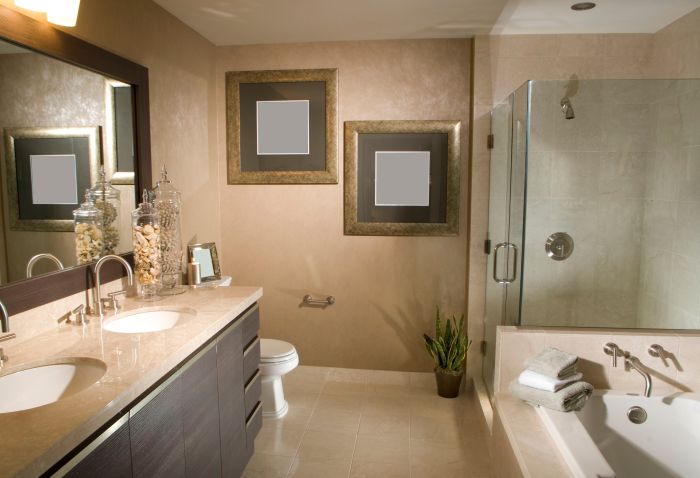
Choosing the right flooring and wall materials for your bathroom is crucial, as they contribute significantly to the overall look, feel, and functionality of the space. These surfaces need to be durable, moisture-resistant, and aesthetically pleasing.
Bathroom Flooring Options
Selecting the appropriate bathroom flooring material depends on your personal preferences, budget, and the style you’re aiming for. Here’s a comparison of popular options:
- Tile: Tile remains a popular choice for bathrooms due to its durability, water resistance, and wide range of styles and colors. Ceramic tile is affordable, while porcelain tile offers greater durability and stain resistance. Natural stone tiles, such as marble, granite, or slate, provide a luxurious look but are more expensive and require specialized maintenance.
- Wood: While not as common as tile, engineered hardwood flooring can be used in bathrooms if properly sealed and maintained. It offers a warm and natural feel but requires careful selection and installation to withstand moisture.
- Vinyl: Vinyl flooring is a cost-effective option that offers good water resistance and durability. It comes in various styles, mimicking tile, wood, or stone, making it a versatile choice.
Bathroom Wall Design
A well-designed bathroom wall layout can enhance the space’s functionality and visual appeal. Consider these elements:
- Tile: Tile is a practical and stylish choice for bathroom walls, particularly in areas prone to splashes, such as the shower or bathtub surround. Different tile sizes, shapes, and patterns can create unique designs, adding visual interest.
- Paint: Painting bathroom walls is a cost-effective way to refresh the space and create a clean and modern look. Choose a paint specifically designed for bathrooms, which is moisture-resistant and mildew-resistant.
- Wallpaper: Wallpaper can add a touch of personality and style to a bathroom, but choose a moisture-resistant and washable option. It’s best used in areas less prone to splashes, such as behind the toilet or vanity.
Bathroom Fixture and Accessory Selection
The bathroom fixtures and accessories you choose should complement the overall design and functionality of the space. Consider these factors:
- Style: Choose fixtures and accessories that align with the bathroom’s style, whether it’s modern, traditional, contemporary, or eclectic.
- Material: Options include chrome, nickel, brass, and stainless steel. Consider the durability, finish, and ease of cleaning when selecting materials.
- Functionality: Choose fixtures that meet your needs, such as a rain showerhead, a double vanity, or a heated towel rack.
- Budget: Set a budget for fixtures and accessories and explore different options within that range.
Bathroom Safety and Accessibility
A bathroom remodel presents a perfect opportunity to enhance safety and accessibility, making your bathroom a comfortable and functional space for everyone. By incorporating thoughtful design elements, you can create a bathroom that is both stylish and safe, ensuring a positive experience for years to come.
Bathroom Safety Features
Safety features are crucial in bathrooms, especially for older adults and individuals with mobility challenges. These features can help prevent falls and injuries, ensuring a secure environment for everyone.
- Grab Bars: Strategically placed grab bars near the toilet, shower, and bathtub provide essential support for balance and stability, reducing the risk of falls.
- Non-Slip Flooring: Selecting slip-resistant flooring materials, such as textured tiles or rubber mats, is essential to minimize the risk of slips and falls, especially in wet areas.
- Adequate Lighting: Well-lit bathrooms are safer. Install bright, even lighting throughout the bathroom, particularly around the shower and vanity areas, to reduce shadows and improve visibility.
Making Your Bathroom Accessible
Creating an accessible bathroom can significantly improve the quality of life for individuals with disabilities. Here are some key considerations for designing an accessible bathroom:
- Wider Doorways: Ensure doorways are at least 32 inches wide to allow easy access for wheelchairs and walkers.
- Roll-In Shower: A roll-in shower with a curbless entry eliminates the need to step over a threshold, making it easier for individuals with mobility limitations to enter and exit.
- Grab Bars: Install grab bars in strategic locations, including near the toilet, shower, and bathtub, to provide support and stability.
- Accessible Toilet: Choose a toilet with a height that is comfortable for individuals who use wheelchairs. Consider a toilet with a raised seat or a commode chair.
- Lowered Vanity: A lowered vanity with an open space underneath allows for easy access for individuals in wheelchairs.
- Lever-Style Faucets: Lever-style faucets are easier to operate than traditional knob-style faucets, especially for individuals with limited hand dexterity.
Creating a Stylish and Functional Bathroom
Balancing safety and accessibility with style is achievable. Here are some tips for creating a bathroom that is both functional and aesthetically pleasing:
- Choose Accessible Fixtures with Style: There are many accessible fixtures available in a wide range of styles and finishes. You can find grab bars that blend seamlessly with your bathroom decor, and toilets and vanities that offer both accessibility and style.
- Use Color and Texture: Use color and texture to create a visually appealing and safe bathroom. Consider using contrasting colors for flooring and walls to improve visibility for individuals with visual impairments. Also, use textured tiles or non-slip mats to provide additional traction.
- Add Personal Touches: Don’t forget to add personal touches to make your bathroom feel like your own. Choose accessories, artwork, and plants that reflect your style and create a welcoming atmosphere.
Bathroom Remodel Cost Considerations
A bathroom remodel can significantly enhance your home’s value and comfort, but it’s essential to consider the associated costs. Understanding the factors that influence the price can help you plan your budget effectively and make informed decisions.
Bathroom Remodel Cost Estimates
The cost of a bathroom remodel can vary greatly depending on the scope of the project, materials used, and labor costs. Here’s a general breakdown of estimated costs based on different levels of complexity:
- Basic Remodel: This involves replacing fixtures, such as the toilet, sink, and vanity, along with minor cosmetic updates. The cost can range from $2,000 to $10,000.
- Mid-Range Remodel: This includes replacing fixtures, updating flooring and walls, and possibly adding a new shower or bathtub. The cost can range from $10,000 to $25,000.
- High-End Remodel: This involves a complete overhaul, including structural changes, custom cabinetry, high-end materials, and advanced features like heated floors or steam showers. The cost can exceed $25,000 and reach upwards of $50,000 or more.
Common Bathroom Remodel Costs
Here’s a list of common costs associated with a bathroom remodel, categorized by labor, materials, and permits:
Labor Costs
- Demolition and Removal: This involves removing old fixtures, flooring, and walls, typically costing $500 to $2,000.
- Plumbing: Replacing or installing new plumbing fixtures and lines can range from $1,000 to $5,000.
- Electrical: Installing new wiring, outlets, and lighting fixtures can cost $1,000 to $3,000.
- Tiling and Grouting: Installing new tile flooring and walls can cost $2,000 to $6,000.
- Cabinetry: Installing new cabinets and vanities can range from $2,000 to $10,000.
- Painting: Painting walls and ceilings can cost $500 to $1,500.
Material Costs
- Fixtures: This includes toilets, sinks, tubs, showers, and faucets, with costs ranging from $500 to $5,000.
- Flooring: This includes tile, hardwood, laminate, or vinyl flooring, with costs ranging from $2 to $15 per square foot.
- Walls: This includes tile, drywall, paint, and wallpaper, with costs varying depending on the material and finish.
- Cabinets: This includes vanity cabinets, medicine cabinets, and storage cabinets, with costs ranging from $500 to $5,000 per cabinet.
- Lighting: This includes vanity lights, ceiling lights, and accent lights, with costs ranging from $50 to $500 per fixture.
Permit Costs
- Building Permits: These are required for structural changes, plumbing, and electrical work, with costs varying by location and project scope.
- Inspection Fees: These are charged for inspections by building officials to ensure code compliance, with costs ranging from $50 to $200 per inspection.
Cost-Saving Strategies
There are several strategies you can implement to reduce the overall cost of your bathroom remodel:
- DIY Projects: If you have the skills and time, you can save money by undertaking some tasks yourself, such as painting, demolition, or installing fixtures.
- Budget-Friendly Materials: Choosing less expensive materials, such as laminate flooring or pre-fabricated cabinets, can significantly reduce costs.
- Shop Around for Labor and Materials: Getting quotes from multiple contractors and suppliers can help you find the best deals.
- Consider Used or Refurbished Fixtures: Buying used or refurbished fixtures can save you money without compromising quality.
Finding a Contractor for Your Bathroom Remodel
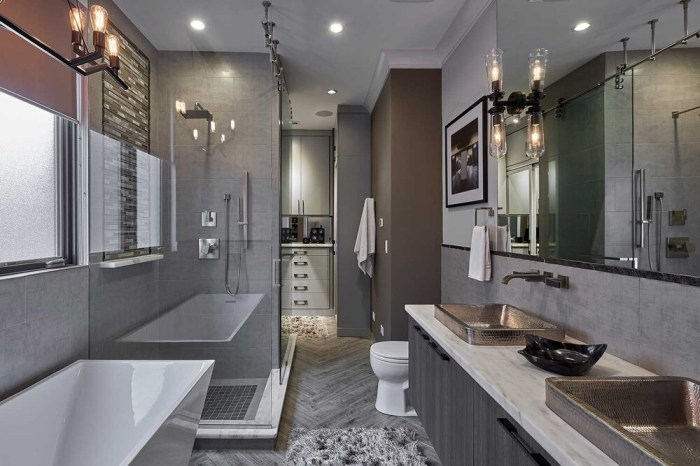
A successful bathroom remodel relies heavily on the expertise and professionalism of your chosen contractor. Selecting the right contractor is crucial to ensure your project runs smoothly, stays within budget, and meets your expectations.
Hiring a Qualified Contractor
Hiring a qualified and experienced contractor is essential for a successful bathroom remodel. A qualified contractor will have the necessary knowledge, skills, and experience to handle all aspects of your project, from planning and design to construction and finishing.
- Experience: Choose a contractor with proven experience in bathroom remodeling projects similar to yours in terms of size and complexity. This ensures they understand the specific challenges and requirements of bathroom renovations.
- License and Insurance: Verify that the contractor is properly licensed and insured. This protects you from potential legal liabilities and financial losses in case of accidents or damages during the project.
- Reputation: Research the contractor’s reputation by checking online reviews, testimonials, and references from past clients. This will give you insights into their professionalism, quality of work, and customer satisfaction.
- Communication Skills: A good contractor will communicate clearly and effectively throughout the project, keeping you informed of progress, addressing concerns, and providing timely updates.
Asking the Right Questions
Asking the right questions to potential contractors is crucial for making an informed decision. This helps you evaluate their experience, expertise, and suitability for your project.
- Experience: Inquire about their experience in bathroom remodeling projects, specifically those similar to yours in scope and complexity.
- Portfolio: Request to see examples of their previous bathroom remodel projects to assess their design aesthetic, craftsmanship, and attention to detail.
- Process: Ask about their project management process, including communication channels, timelines, and how they handle changes or unforeseen issues.
- Team: Inquire about the size and expertise of their team, ensuring they have qualified subcontractors for specialized tasks like plumbing, electrical, and tile work.
- Warranty: Ask about their warranty policies for workmanship and materials, providing you with peace of mind and protection against defects or issues.
Creating a Clear Contract
A well-written contract is essential for protecting your interests and ensuring a successful project. It Articulates the scope of work, budget, and timeline, minimizing misunderstandings and disputes.
- Scope of Work: The contract should clearly define the specific tasks included in the project, including materials, fixtures, and finishes. Detailed descriptions and specifications help avoid ambiguity and ensure everyone is on the same page.
- Budget: The contract should specify the total project cost, including labor, materials, permits, and any other expenses. It should also detail payment terms and schedule.
- Timeline: The contract should include a realistic project timeline with clear milestones and deadlines. This helps ensure the project progresses on schedule and avoids delays.
- Contingency Plan: Include provisions for handling unexpected issues or changes. This could involve a clause outlining how cost overruns or delays will be addressed.
- Dispute Resolution: The contract should include a mechanism for resolving disputes or disagreements that may arise during the project.
Bathroom Remodel Inspiration and Ideas
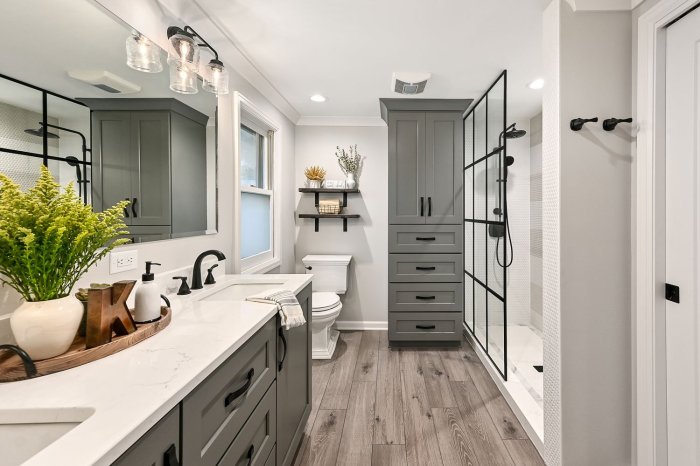
Transforming your bathroom into a haven of relaxation and functionality is an exciting journey. To help you envision the possibilities, we’ve compiled a selection of bathroom design ideas, resources, and tips to inspire your remodel.
Visual Gallery of Bathroom Design Ideas
Visualizing your dream bathroom is essential to making informed decisions. Here are some bathroom design ideas to ignite your imagination:
- Small Bathroom Layouts: Space-saving solutions for compact bathrooms, showcasing clever storage, maximized functionality, and visually appealing designs.
- Modern Bathroom Designs: Minimalist aesthetics, clean lines, sleek fixtures, and innovative materials create a contemporary and sophisticated ambiance.
- Spa-Inspired Bathrooms: Creating a tranquil oasis, featuring natural materials, soft lighting, calming color palettes, and luxurious amenities like soaking tubs and rain showers.
Resources for Finding Bathroom Remodel Inspiration
Exploring a variety of resources can spark creativity and help you refine your vision. Here are some sources for finding inspiration:
- Home Design Magazines: Publications like “Architectural Digest,” “Elle Decor,” and “House Beautiful” feature stunning bathroom design ideas, showcasing the latest trends and innovative solutions.
- Websites: Online platforms like Houzz, Pinterest, and Design Sponge offer a vast collection of bathroom remodel inspiration, from photos and design ideas to product recommendations and contractor reviews.
- Social Media Platforms: Instagram, Facebook, and TikTok are excellent platforms for discovering inspiring bathroom designs, following design professionals, and connecting with other homeowners undergoing similar renovations.
Sharing Your Bathroom Remodel Stories and Tips
Your personal experiences and insights are valuable. Sharing your bathroom remodel journey, including challenges, triumphs, and tips can inspire and help others. Consider sharing your stories and advice through:
- Online Forums: Websites like Reddit and Houzz have dedicated forums where homeowners can connect, share their experiences, and seek advice from others.
- Social Media Groups: Facebook groups and Instagram communities centered around home improvement and bathroom renovations offer a supportive space for sharing your project journey.
- Blogs and Websites: Creating a blog or website to document your bathroom remodel can be a rewarding way to share your expertise and connect with others interested in similar projects.
End of Discussion
A home bathroom remodel is a significant investment that can enhance your quality of life for years to come. By following the steps Artikel in this guide, you can create a bathroom that is both beautiful and functional, reflecting your unique style and fulfilling your needs.
Remember, the key to a successful remodel lies in thorough planning, meticulous execution, and a touch of personal creativity.
Comments are closed.